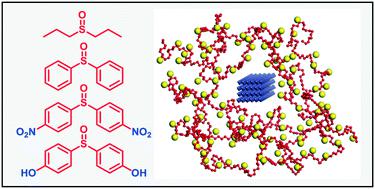当前位置:
X-MOL 学术
›
Mol. Syst. Des. Eng.
›
论文详情
Our official English website, www.x-mol.net, welcomes your
feedback! (Note: you will need to create a separate account there.)
Effect of substituents in sulfoxides on the enhancement of thermoelectric properties of PEDOT:PSS: experimental and modelling evidence
Molecular Systems Design & Engineering ( IF 3.2 ) Pub Date : 2020-05-05 , DOI: 10.1039/d0me00032a Qiang Zhu 1, 2, 3, 4 , Erol Yildirim 4, 5, 6, 7, 8 , Xizu Wang 1, 2, 3, 4 , Aung Ko Ko Kyaw 1, 2, 3, 4 , Tao Tang 1, 2, 3, 4 , Xiang Yun Debbie Soo 1, 2, 3, 4 , Zicong Marvin Wong 4, 5, 6 , Gang Wu 4, 5, 6 , Shuo-Wang Yang 4, 5, 6 , Jianwei Xu 1, 2, 3, 4, 7
Molecular Systems Design & Engineering ( IF 3.2 ) Pub Date : 2020-05-05 , DOI: 10.1039/d0me00032a Qiang Zhu 1, 2, 3, 4 , Erol Yildirim 4, 5, 6, 7, 8 , Xizu Wang 1, 2, 3, 4 , Aung Ko Ko Kyaw 1, 2, 3, 4 , Tao Tang 1, 2, 3, 4 , Xiang Yun Debbie Soo 1, 2, 3, 4 , Zicong Marvin Wong 4, 5, 6 , Gang Wu 4, 5, 6 , Shuo-Wang Yang 4, 5, 6 , Jianwei Xu 1, 2, 3, 4, 7
Affiliation

|
Poly(3,4-ethylenedioxythiophene):poly(styrenesulfonate) (PEDOT:PSS), being the most popular conductive polymer, has been doped with various additives with the aim of improving its thermoelectric performance. Among all additives, dimethyl sulfoxide (DMSO) has been widely used for various treatments. In this work, we designed and synthesized a series of aliphatic- and aromatic-substituted sulfoxides as dopants to improve the thermoelectric properties of PEDOT:PSS. It was found that the substituents in the sulfoxides played a vital role in controlling the thermoelectric properties. Sulfoxides with relatively longer alkyl chains and large phenyl groups increased the electrical conductivity of PEDOT:PSS to more than 200 S cm−1 compared to the pristine PEDOT:PSS film. The sulfoxide with 4-nitrophenyl substituents, however, led to negligible changes in electrical conductivity but increased the Seebeck coefficient from 22 to 56 μV K−1. In contrast, the sulfoxide with 4-hydroxyphenyl substituents remarkably improved both the electrical conductivity and Seebeck coefficient, leading to a power factor of up to 69 μW m−1 K−2, much higher than that of the PEDOT:PSS film which was obtained by simply mixing with DMSO. Several simulation methods were used to evaluate various interactions between sulfoxides, PEDOT, and PSS to elucidate the mechanisms, revealing that the sulfoxide with 4-hydroxyphenyl groups exhibited additional interaction with the PSS phase, while the sulfoxide with 4-nitrophenyl groups showed strong interaction with the PEDOT phase instead and hence disrupted electrical conductivity. Our findings would uncover the mechanism of electrical conductivity enhancement, providing a general strategy for designing promising alternative additives for PEDOT:PSS treatment and eventually achieving better thermoelectric properties.
中文翻译:

亚砜中取代基对增强PEDOT:PSS热电性能的影响:实验和模型证据
聚(3,4-乙撑二氧噻吩):聚(苯乙烯磺酸盐)(PEDOT:PSS)是最流行的导电聚合物,为了改善其热电性能,已掺入了各种添加剂。在所有添加剂中,二甲基亚砜(DMSO)已被广泛用于各种处理。在这项工作中,我们设计并合成了一系列脂族和芳族取代的亚砜作为掺杂剂,以改善PEDOT:PSS的热电性能。发现亚砜中的取代基在控制热电性质中起着至关重要的作用。具有相对较长烷基链和较大苯基的亚砜将PEDOT:PSS的电导率提高到200 S cm -1以上与原始的PEDOT:PSS胶片相比。然而,具有4-硝基苯基取代基的亚砜导致电导率的变化可忽略不计,但是塞贝克系数从22μVK -1增加到56μVK -1。相比之下,具有4-羟苯基取代基的亚砜显着提高了电导率和塞贝克系数,从而导致功率因数高达69μWm -1 K -2,远远高于通过简单地与DMSO混合而获得的PEDOT:PSS膜。几种模拟方法用于评估亚砜,PEDOT和PSS之间的各种相互作用,以阐明机理,发现具有4-羟基苯基的亚砜与PSS相表现出额外的相互作用,而具有4-硝基苯基的亚砜与PSS相表现出强相互作用。 PEDOT相反而破坏了电导率。我们的发现将揭示电导率增强的机制,为设计用于PEDOT:PSS处理的有希望的替代添加剂并最终实现更好的热电性能提供一种通用策略。
更新日期:2020-05-05
中文翻译:

亚砜中取代基对增强PEDOT:PSS热电性能的影响:实验和模型证据
聚(3,4-乙撑二氧噻吩):聚(苯乙烯磺酸盐)(PEDOT:PSS)是最流行的导电聚合物,为了改善其热电性能,已掺入了各种添加剂。在所有添加剂中,二甲基亚砜(DMSO)已被广泛用于各种处理。在这项工作中,我们设计并合成了一系列脂族和芳族取代的亚砜作为掺杂剂,以改善PEDOT:PSS的热电性能。发现亚砜中的取代基在控制热电性质中起着至关重要的作用。具有相对较长烷基链和较大苯基的亚砜将PEDOT:PSS的电导率提高到200 S cm -1以上与原始的PEDOT:PSS胶片相比。然而,具有4-硝基苯基取代基的亚砜导致电导率的变化可忽略不计,但是塞贝克系数从22μVK -1增加到56μVK -1。相比之下,具有4-羟苯基取代基的亚砜显着提高了电导率和塞贝克系数,从而导致功率因数高达69μWm -1 K -2,远远高于通过简单地与DMSO混合而获得的PEDOT:PSS膜。几种模拟方法用于评估亚砜,PEDOT和PSS之间的各种相互作用,以阐明机理,发现具有4-羟基苯基的亚砜与PSS相表现出额外的相互作用,而具有4-硝基苯基的亚砜与PSS相表现出强相互作用。 PEDOT相反而破坏了电导率。我们的发现将揭示电导率增强的机制,为设计用于PEDOT:PSS处理的有希望的替代添加剂并最终实现更好的热电性能提供一种通用策略。











































 京公网安备 11010802027423号
京公网安备 11010802027423号